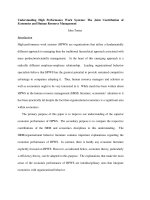HUman resource managemenr 2e s keiman chapter8
Bạn đang xem bản rút gọn của tài liệu. Xem và tải ngay bản đầy đủ của tài liệu tại đây (128.17 KB, 37 trang )
Chapter 8
Appraising Employee Job Performance
© 2010 Cengage Learning. Atomic Dog is a trademark used herein under license. All rights reserved.
Chapter Outline
•
8-1 Gaining Competitive Advantage
•
8-2 HRM Issues and Practices
•
8-3 The Manager’s Guide
© 2010 Cengage Learning. Atomic Dog is a trademark used herein under license. All rights reserved.
8-1a Opening Case: Gaining Competitive
Advantage at McKesson Information
Solutions
•
Problem: An inadequate performance appraisal
system.
•
Solution: Develop an effective performance appraisal
system.
•
How the new performance appraisal system
enhanced competitive advantage
Workforce has become much more motivated.
Employees’ job satisfaction levels have enhanced.
Retention rates have increased.
© 2010 Cengage Learning. Atomic Dog is a trademark used herein under license. All rights reserved.
8-1b Linking Performance Appraisal
to Competitive Advantage
•
Performance appraisals should accurately assess
the quality of employee job performance.
•
Job performance can be improved in two ways:
Directing employee behavior towards organizational
goals.
Monitoring behavior to ensure that goals are met.
© 2010 Cengage Learning. Atomic Dog is a trademark used herein under license. All rights reserved.
Figure 8-1 Performance Appraisals Can
Help Assess the Quality of Employee
Performance
© 2010 Cengage Learning. Atomic Dog is a trademark used herein under license. All rights reserved.
8-2a Standards for Effective Performance
Appraisal Systems
•
The quality of the rating form
•
Accuracy of the ratings
•
Legal standards
© 2010 Cengage Learning. Atomic Dog is a trademark used herein under license. All rights reserved.
8-2a Standards for Effective Performance
Appraisal Systems (cont.)
•
The quality of the rating form
Relevance
-
The degree to which the rating form includes necessary
information.
Criterion deficiency: Omission of pertinent performance
criteria.
Criterion contamination: Inclusion of irrelevant criteria on
the rating form.
© 2010 Cengage Learning. Atomic Dog is a trademark used herein under license. All rights reserved.
8-2a Standards for Effective Performance
Appraisal Systems (cont.)
•
The quality of the rating form (cont.)
Clear performance standards
-
Indicate the level of performance an employee is
expected to achieve.
Help direct employee behavior.
Help supervisors provide more accurate ratings.
© 2010 Cengage Learning. Atomic Dog is a trademark used herein under license. All rights reserved.
8-2a Standards for Effective Performance
Appraisal Systems (cont.)
•
Accuracy of the ratings
Accurate ratings reflect the employees’ actual job
performance levels.
Inaccuracy is most often attributable to the presence
of rater errors.
© 2010 Cengage Learning. Atomic Dog is a trademark used herein under license. All rights reserved.
8-2a Standards for Effective Performance
Appraisal Systems (cont.)
•
Leniency error: Raters provide ratings that are unduly
high.
•
Severity error: Ratings are unduly low.
•
Causes of leniency and severity errors:
Political reasons
Raters’ lack of conscientiousness
Personal bias
© 2010 Cengage Learning. Atomic Dog is a trademark used herein under license. All rights reserved.
8-2a Standards for Effective Performance
Appraisal Systems (cont.)
•
Central tendency error: Appraisers purposely avoid
giving extreme ratings even when such ratings are
warranted.
•
Causes of central tendency error:
Administrative procedures.
End points of the rating scale are unrealistically
defined.
© 2010 Cengage Learning. Atomic Dog is a trademark used herein under license. All rights reserved.
8-2a Standards for Effective Performance
Appraisal Systems (cont.)
•
Halo effect:
Appraiser’s overall impression of an employee is
based on a particular characteristic.
Acts as a barrier to accurate appraisals.
Caused due to vague rating standards and failure to
conscientiously complete the rating form.
© 2010 Cengage Learning. Atomic Dog is a trademark used herein under license. All rights reserved.
8-2a Standards for Effective Performance
Appraisal Systems (cont.)
•
The rater’s use of implicit personality theory
Implicit personality theory: Rater’s estimation based on
a personal “theory” of how different types of people
behave in certain situations.
Using this theory, organizations are unable to identify
employees’ specific strengths and weaknesses.
© 2010 Cengage Learning. Atomic Dog is a trademark used herein under license. All rights reserved.
8-2a Standards for Effective Performance
Appraisal Systems (cont.)
•
Recency error
Is a consequence of memory decay.
Ratings are heavily influenced by recent events that
are more easily remembered.
Ratings that unduly reflect recent events can present a
false picture of the individual’s job performance during
the entire rating period.
© 2010 Cengage Learning. Atomic Dog is a trademark used herein under license. All rights reserved.
8-2a Standards for Effective Performance
Appraisal Systems (cont.)
•
Legal standards
Appraisal systems must meet all the criteria imposed
by EEO laws.
Specifically, a court would examine the:
-
Nature of the appraisal instrument.
Fairness and accuracy of the ratings.
© 2010 Cengage Learning. Atomic Dog is a trademark used herein under license. All rights reserved.
8-2b Types of Rating Instruments
•
Employee comparison systems
•
Graphic rating scale (GRS)
•
Behaviorally anchored rating scale (BARS)
•
Behavior observation scale (BOS)
•
Management by objectives (MBO)
© 2010 Cengage Learning. Atomic Dog is a trademark used herein under license. All rights reserved.
8-2b Types of Rating Instruments (cont.)
•
Employee comparison systems
Employee performance is evaluated relative to other
employees’ performances.
Uses rankings rather than ratings.
Ranking formats:
-
-
Simple rankings: Require raters to rank-order their
employees from best to worst, according to their job
performance.
Paired comparison: A rater compares each possible pair
of employees.
Forced distribution: Requires a rater to assign a certain
percentage of employees to each category of excellence
such as “best,” “average,” or “worst.”
© 2010 Cengage Learning. Atomic Dog is a trademark used herein under license. All rights reserved.
8-2b Types of Rating Instruments (cont.)
•
Employee comparison systems
•
Strengths
Low cost and practical.
Take very little time and
effort.
Eliminates some rating
errors.
Employment decisions
become much easier to
make.
• Weaknesses
Disrupts teamwork.
Accuracy and fairness
questioned.
Fails to adequately direct
employee behavior.
Performance of people
from different departments
cannot be compared.
© 2010 Cengage Learning. Atomic Dog is a trademark used herein under license. All rights reserved.
8-2b Types of Rating Instruments (cont.)
•
Graphic rating scales
Presents appraisers with a list of traits assumed to be
necessary to successful job performance.
A five- or seven-point rating scale accompanies each
trait.
Points on the scale are defined by numbers and/or
descriptive words or phrases that indicate level of
performance.
© 2010 Cengage Learning. Atomic Dog is a trademark used herein under license. All rights reserved.
8-2b Types of Rating Instruments (cont.)
•
Graphic rating scales
• Strengths
Practical.
Low cost.
Can be developed
quickly.
A single form is
applicable to all or most
jobs within an
organization.
• Weaknesses
Vaguely defined traits to
evaluate (e.g. demeanor or
attitude)
Does not effectively direct
behavior.
Fails to provide specific,
nonthreatening feedback.
Accurate ratings are not likely
to be achieved.
Can lead to a multitude of
rating errors.
Occurrence of bias.
© 2010 Cengage Learning. Atomic Dog is a trademark used herein under license. All rights reserved.
8-2b Types of Rating Instruments (cont.)
•
Behaviorally anchored rating scales (BARS)
Similar to graphic rating scale.
Requires appraisers to rate employees on their traits.
Includes seven or eight traits, referred to as
“dimensions,” each anchored by a seven- or nine-point
scale.
Anchors each trait with examples of specific job
behaviors that reflect varying levels of performance.
© 2010 Cengage Learning. Atomic Dog is a trademark used herein under license. All rights reserved.
8-2b Types of Rating Instruments (cont.)
•
Behaviorally anchored rating scales (BARS)
• Strengths
Ability to direct and
monitor behavior.
• Weaknesses
Difficult to select one
behavior that is most
indicative of the
employee’s performance.
Time consuming to
develop.
Requires a lot of effort to
develop.
© 2010 Cengage Learning. Atomic Dog is a trademark used herein under license. All rights reserved.
8-2b Types of Rating Instruments (cont.)
•
Behavior observation scales (BOS)
Contains a list of desired behaviors required for the
successful performance of specific jobs.
Developed like BARS, where critical incidents are
collected and categorized into dimensions.
An appraiser rates job performance by indicating the
frequency with which the employee engages in each
behavior.
A five-point scale is used ranging from “almost never”
(1) to “almost always” (5).
© 2010 Cengage Learning. Atomic Dog is a trademark used herein under license. All rights reserved.
8-2b Types of Rating Instruments (cont.)
•
Behavior observation scales (BOS)
• Strengths
Is more legally defensible
than BARS or graphic
rating scales.
Effective in directing
employees’ behavior.
Used to monitor behavior
and give specific
feedback.
• Weaknesses
Time consuming to
develop.
Not always cost-effective.
© 2010 Cengage Learning. Atomic Dog is a trademark used herein under license. All rights reserved.
8-2b Types of Rating Instruments (cont.)
•
Management by objectives (MBO)
A management system designed to achieve
organizational effectiveness by steering each
employee’s behavior towards the organization’s
mission.
MBO process includes:
-
Goal setting: Establishment of the organization’s
mission statement and strategic goals.
Planning: Identify potential obstacles to reaching goals
and devise strategies to overcome these obstacles.
Evaluation: Success at meeting goals is evaluated
against agreed-on performance standards.
© 2010 Cengage Learning. Atomic Dog is a trademark used herein under license. All rights reserved.




![audio engineering 101 [electronic resource] a beginner's guide to music production](https://media.store123doc.com/images/document/14/y/ii/medium_iij1401381447.jpg)
![broken markets [electronic resource] a user's guide to the post-finance economy](https://media.store123doc.com/images/document/14/y/kz/medium_kzd1401381668.jpg)
![ios sdk programming [electronic resource] a beginner's guide](https://media.store123doc.com/images/document/14/y/ph/medium_phw1401472929.jpg)


